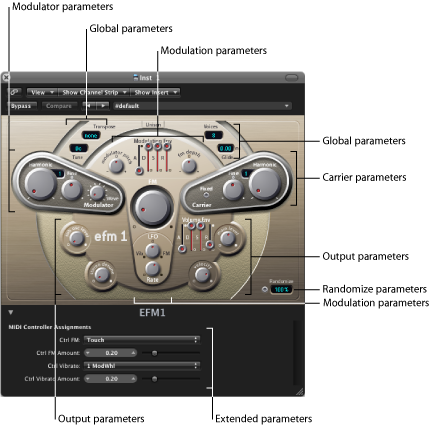Getting to Know the EFM1 Interface
Before you take a look at the individual parameters of the EFM1, this section will familiarize you with the various elements that constitute the EFM1 graphical interface.

The EFM1 is divided into several areas.
- Global parameters: The top section contains parameters that set the overall tuning of the EFM1. Further controls enable you to set the Glide (portamento) time, limit the number of voices, and to thicken the sound with Unison. See Adjusting Global EFM1 Parameters.
- Modulator and Carrier parameters: The FM engine consists of the Modulator and Carrier parameters (raised, darker sections), and the FM Intensity knob (in the center). These are the key controls for setting the basic tone of the EFM1. See Working with the EFM1 Modulator and Carrier Parameters.
- Modulation parameters: The modulation envelope and LFO shown at the top and bottom of the mushroom-shaped area in the center, respectively, are used to animate the sound. See Working with the EFM1 Modulation Parameters.
- Output parameters: The bottom section houses the Output section, which features the Sub Osc Level and Stereo Detune knobs, that can be used to thicken the sound. The volume envelope, Main Level, and Velocity controls are used to set the EFM1 level. See Setting EFM1 Output Parameters.
- Randomize parameters: The Randomize field and button are shown to the lower right. They are used to create random variations of the current settings, resulting in new sounds. See Creating EFM1 Random Sound Variations.
- Extended parameters: Accessed by clicking the disclosure triangle at the lower left of the interface, these parameters allow you to assign MIDI controllers to the FM Depth and Vibrato parameters. See Assigning EFM1 MIDI Controllers.